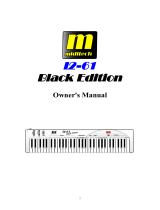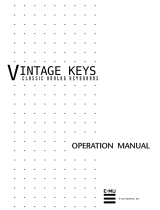
3
MP10 Feature Highlights
The best keyboard action available in a stage piano
The MP10 utilises Kawai’s RM3 Grand wooden-key action, incorporating various grand piano action characteristics, such as contrasting
hammer weights - appropriately graded for each playing range - bass key counter-balancing, and correctly located pivot points for both
black and white keys. This unique ‘seesaw’ movement provides a consistent, evenly balanced action, while nely textured Ivory Touch key
surfaces not only enhance the enjoyment of playing, but also help to absorb moisture, thus preventing ngers from slipping.
In addition, the MP10’s keyboard action is equipped with a special Let-o feature, accurately recreating the subtle ‘click’ sensation felt
when playing the keys of a grand piano very gently.
PIANO section: The ultimate grand pianos for Concert, Pop, and Jazz
The MP10 captures the beautiful sound of Kawai’s highly acclaimed hand-built concert grand piano, with all 88 keys of this exceptional
instrument meticulously recorded, analysed and faithfully reproduced using proprietary Ultra Progressive Harmonic Imaging™ technology.
This unique process accurately recreates the broad dynamic range of the original grand piano, aording pianists an extraordinary level of
expressiveness ranging from the softest pianissimo to the strongest, boldest fortissimo.
With separate categories for Concert, Pop, and Jazz playing, the MP10 oers the nest selection of high quality acoustic piano sounds ever
compiled for a Kawai instrument, while additional techniques and eects, such as string and damper resonance, and subtle key-release
sounds, are also applied, delivering a rich selection of vibrant piano tones with breathtaking realism and authenticity.
E.PIANOsection:BrandnewvintageEPs,twineects,andampsim
The MP10 features a selection of brand new vintage electric piano sounds, each with their own distinctive characteristics. Enjoy their
natural, organic sound, or pass the signal through a variety of classic eects stomp boxes, before playing it through one of the six classic
amp and speaker cabinets
SUBsection:Highqualitystrings,pads,andmore
The MP10’s SUB section features high quality strings, pads, and other useful sounds that are ideal for layering with acoustic or electric
pianos, or for playing individually, at the front of the mix. Feature functions such as Bell and Sweep add further variety to the sound, while
typical ADSR parameters and resonance/cut-o can all be adjusted directly from the panel’s assignable knobs.
MIDI section: Master keyboard controller
The MP10 features a dedicated MIDI section for controlling external devices, or integrating into the studio as a master keyboard. Use
the assignable panel knobs to send CC# to connected hardware, or the recorder transport buttons to control a DAW without touching a
mouse or leaving the piano. The MP10 even includes LINE IN jacks and a dedicated panel fader to adjust the level of connected devices,
such as that old expander module or synth that you just can’t live without, or a laptop running software instruments.
Intuitive operation, large LCD, real-time assignable control knobs
The MP10’s control panel is clearly arranged and easy to use, with related functions grouped together and placed where you’d expect to
nd them. A large LCD display and four assignable control knobs, allow several parameters to be adjusted directly in real-time, without
getting lost in menus - concentrate on playing, rather than trying to remember which button does what.
156 Setup memories: enough for the busiest stage musician
The MP10 allows every single customised sound, knob position, fader level, and adjustable parameter to be stored in memory as a SETUP,
and recalled at the touch of a button. With over 150 SETUP memories, the MP10 is ideal for busy stage musicians who like to plan several
shows ahead, before going out on the road.
USB to Device functionality, with MP3/WAV/SMF le recording and playback.
The MP10 is equipped with USB connectors that not only allow the instrument to be connected to a computer for MIDI use, but also
to load and save data to USB memory devices directly. This ‘USB to Device’ feature allows customised sounds, SETUP memories, and
recorder songs stored in internal memory to be saved to USB for posterity.
USB memory devices can also be used to play back MP3 or WAV audio or SMF MIDI les, allowing performing musicians to play along with
professional backing tracks, or simply learn the chords or melody for a new piece. It is even possible to save performances directly as MP3,
WAV, or SMF les for emailing to band members, casual listening away from the keyboard, or further editing using an audio workstation.
Welcome to the MP10





















